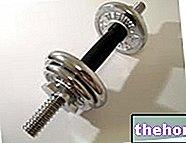
Also called "total body training", this system is the exact opposite of split workout or split training, that is, the division of muscle groups into two or more sessions in the same micro-cycle - generally weekly, but also shorter or longer.
The full body workout is to be associated with the concept of multifrequency, that is the repetition of the training stimulus in the micro cycle. This is because, if aimed at itself, therefore not complementary or preparatory to other disciplines, total body training does not lend itself to monofrequency.
Note: although rarely, some athletes manage to associate the split workout with the concept of multi-frequency; this can be possible by adopting various precautions such as: lengthening the micro cycle period, training even on weekends, reducing the number of splits, training daily, eliminating total recovery days, etc.
The main advantage of the full body workout is to "train" more than the "splitting", from a central nervous and neuro-muscular point of view. The disadvantage, on the other hand, is that of requiring long lead times, sometimes difficult to sustain, especially in hypertrophy protocols.
In this article we will try to better understand how the full body workout develops and its potential effectiveness, proposing some examples of planning and programming, as well as a "typical" training schedule.
Full body workout and goal
If the goal of the full body workout is to increase pure strength, it can be considered an excellent way to reduce the number of sessions and repeat the number of stimuli in the micro cycle. This is because to stimulate this ability it is not essential to perform long routines reaching muscle exhaustion. It follows that the workouts are completed in a short time and recovery can take place quickly, favoring multi-frequency and room for improvement.
On the other hand, if the goal is hypertrophy, the matter becomes more complicated. To increase muscle mass it is always necessary to impose a fairly intense stress (mechanical and chemical-hormonal), training to failure or almost, with high volume, density and TUT (time under tension). This takes much longer to stress each single muscle group, making workouts endless, as well as being difficult to sustain due to metabolic fatigue. Even if desired, it will hardly be possible to apply the multifrequency to a full body workout for pure hypertrophy.
On the other hand, it is necessary to appreciate the applicability of the full body workout for the stimulation of short-term resistance, in particular of resistance to strength (a few minutes). It is quite common, especially in general preparation for other sports, to organize these workouts in circuit training, repeating them even many times in the micro cycle.
Full body workout and level of preparation
The main advantage of the full body workout is to effectively stimulate technical learning, in terms of balance, coordination of motor patterns, neuromuscular activation and synchronization, etc. That is why it is recommended for beginner training.
It can also be used effectively in certain periods of the year for those who are at an average level, as long as one is careful to constantly modify it according to needs (by extending, for example, the duration of microcycles).
On the contrary, an expert body builder will hardly be able to use the full body workout in the search for hypertrophy; for this category, on the other hand, it is an "excellent solution in transitional periods, between the end of the cutting phase and maintenance in the regeneration period (for example during holidays).
Full body workout and intensity, density and volume of work
The relevance of the full body workout depends a lot on these three elements, both within the single workout and the micro cycle. Training the whole body subjects the mind, muscles and organs to a rather high workload. Managing the general load various solutions can be found, provided that the mechanisms underlying our objective are not lost sight of.
It is true that with this system it is possible to complete the stimulation of the entire muscular system in a single session, and that in this way it is also possible to increase the stimuli in the micro cycle. muscle tension, such as exhaustion of phosphate groups, production of lactic acid, etc.
Full body workout and subjective ability to reach exhaustion
Not everyone, for organic or psychological reasons, is capable of reaching such intensity as to be totally exhausted at the end of each workout. We are not talking about fatigue, but about exhaustion. You are as exhausted in a particular district as it is almost impossible to perform the normal gestures of daily life - at least, for the first moments after training.
Especially to the "hardest" it may seem difficult to believe but, using the full body workout, it is much more difficult to reach exhaustion. This is because the general metabolic fatigue becomes such that it is almost impossible to push to certain levels for all muscle groups. This becomes a real limit, both for the level of the stimulus that one would like to reach, and for the psychological capacity to carry on the eventual training schedule for 8-10 weeks.
Full body workout and subjective recovery capacity
As anticipated, it depends on the age, the diet, the integration and the personal organism. We are not all the same. Also with reference to what has been said in the two paragraphs above, let's not forget that in pursuing the goal of hypertrophy it may not be easy to recover between two full body workouts at a short distance from each other. If recovery is incomplete, supercompensation does not occur. Then, it is legitimate to hypothesize that by increasing the stimuli the organism reacts by speeding up this process, but in this regard it would be better to insert short periods of over-stimulation, in order to also reduce the risk of "doing damage", or in any case of not progressing.
It is good to remember that by training beyond normal, nutritional needs also become exceptional. We are not talking about quantity, but about quality. It is not the aim of this article to go into the merits of how many proteins, carbohydrates, vitamins and minerals a bodybuilder needs. Surely no more than any strength athlete, but it is good that at least those are well present in the diet. Only where not the food arrives, it is advisable to integrate.
only once, even if for more time in the same sessionWhat are the disadvantages of the full body workout compared to the split?
The disadvantages of the full body workout, which can also be easily extrapolated from the above, are actually few but important:
- Poor relevance in the search for high-level hypertrophy
- With high workloads, long-term sustainability is difficult
- Greater statistical possibility of injury; at each workout, care must be taken to warm up well and activate all joints, tendons and muscles.
Example of a full body workout workout A, B, C for hypertrophy
Note: It is advisable to approach this training with caution, especially starting from a low level.




























